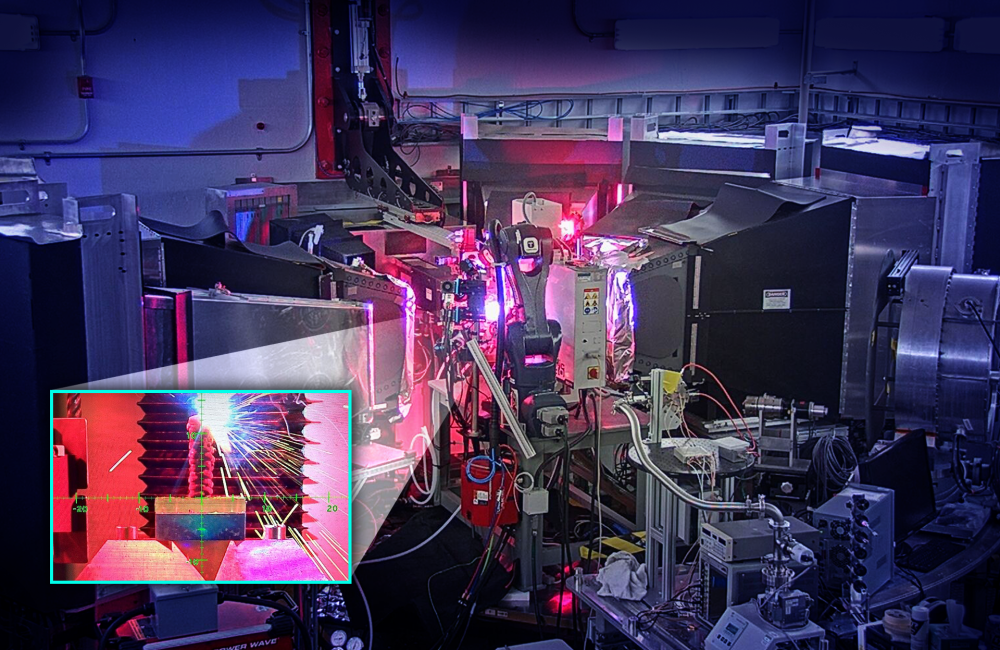By employing neutrons to observe the additive manufacturing process at the atomic level, scientists have successfully demonstrated their ability to measure strain in a material as it undergoes changes and monitor the atomic movements in response to stress.
 The OpeN-AM experimental platform, installed at the VULCAN instrument at ORNL’s Spallation Neutron Source, features a robotic arm that prints layers of molten metal to create complex shapes. This allows scientists to study 3D printed welds microscopically. Credit: Jill Hemman, ORNL/US Department of Energy
The OpeN-AM experimental platform, installed at the VULCAN instrument at ORNL’s Spallation Neutron Source, features a robotic arm that prints layers of molten metal to create complex shapes. This allows scientists to study 3D printed welds microscopically. Credit: Jill Hemman, ORNL/US Department of Energy
The automotive, aerospace, clean energy, and tool-and-die industries — any industry that needs complex and high-performance parts — could use additive manufacturing.
Alex Plotkowski, Materials Scientist, Materials Science and Technology Division, Oak Ridge National Laboratory
Alex Plotkowski is the lead scientist of the experiment. Plotkowski and his co-workers published their findings in the journal Nature Communications.
Researchers at ORNL have introduced OpeN-AM, a 3D printing platform, which, in conjunction with the VULCAN beamline at ORNL's Spallation Neutron Source (SNS), a Department of Energy Office of Science user facility, can continuously measure evolving residual stress during the manufacturing process.
Integrating infrared imaging and computer modeling with this system provides an unparalleled understanding of material behavior throughout the manufacturing process.
Here, scientists utilized low-temperature transformation (LTT) steel and physically tracked the movement of atoms in response to stress, whether it was due to changes in temperature or applied load, by employing the OpeN-AM platform.
Residual stresses, which are the stresses that persist even after the external load or source of stress has been removed, can lead to material deformation or, even more critically, premature material failure. Addressing these residual stresses is a significant challenge when aiming to produce precise components with the desired properties and performance.
The scientists conceptualized and, over a span of two years, executed an experiment that can gauge the evolving strain in the material, a factor that plays a pivotal role in determining how stresses will be distributed.
Manufacturers will be able to tailor residual stress in their components, increasing their strength, making them lighter and in more complex shapes. The technology can be applied to anything you want to manufacture. We have successfully shown that there is a way to do that. We are demonstrating we understand connections in one case to anticipate other cases.
Alex Plotkowski, Materials Scientist, Materials Science and Technology Division, Oak Ridge National Laboratory
The scientists have recently been honored with a 2023 R&D 100 Award for this groundbreaking technology. The winners were unveiled by R&D World magazine in August, and the award ceremony to acknowledge Plotkowski and other recipients is scheduled for November 16 in San Diego.
The scientists harnessed a tailor-made wire-arc additive manufacturing platform to conduct what is known as operando neutron diffraction on an LTT (low-temperature transformation) metal at the SNS. Leveraging the capabilities of the SNS's VULCAN beamline, they processed the steel and collected data at various stages throughout the manufacturing process and after it had cooled to room temperature. This data was then cross-validated by incorporating diffraction information with infrared imaging.
The system was developed and constructed at the Manufacturing Demonstration Facility (MDF), a user consortium of the DOE Advanced Materials and Manufacturing Technologies Office. Additionally, a replicate system of this platform was built at MDF to plan and test experiments before their execution at the beamline.
The SNS operates a linear particle accelerator capable of generating neutron beams for the detailed examination and analysis of materials at the atomic level. The research tool created by the scientists enables a unique capability – it allows researchers to look inside a material while it is being manufactured, essentially providing real-time observations of the underlying mechanisms at play.
The LTT steel was subjected to a process where it was melted and deposited in layers. During the subsequent solidification and cooling of the metal, it underwent a phase transformation. In a phase transformation, the arrangement of atoms changes, leading to differences in the material's behavior.
Typically, transformations that occur at high temperatures can be challenging to comprehend when examining a material after it has undergone processing. However, by observing the LTT steel during the actual processing, the scientists' experiment demonstrates their ability to not only comprehend but also manipulate the phase transformation, providing valuable insights into the material's behavior.
We want to understand what these stresses are, explain how they got there, and figure out how to control them.
Alex Plotkowski, Materials Scientist, Materials Science and Technology Division, Oak Ridge National Laboratory
“These results provide a new pathway to design desirable residual stress states and property distributions within additive manufacturing components by using process controls to improve nonuniform spatial and temporal variations of thermal gradients around key phase transformation temperatures,” the authors noted.
Plotkowski expresses the hope that scientists from various parts of the world will be drawn to ORNL to conduct comparable experiments on metals they intend to employ in manufacturing.
The research was financially supported by ORNL's Laboratory Directed Research and Development program, which is dedicated to supporting high-risk research and development endeavors in areas that hold significant potential value for national programs.
ORNL’s Chris Fancher, James Haley, Ke An, Rangasayee Kannan, Thomas Feldhausen, Yousub Lee, Dunji Yu, and Joshua Vaughan; University of Tennessee-ORNL Governor’s Chair Suresh Babu; and former ORNL researchers Kyle Saleeby, Guru Madireddy and C. Leach are the co-authors of the study.